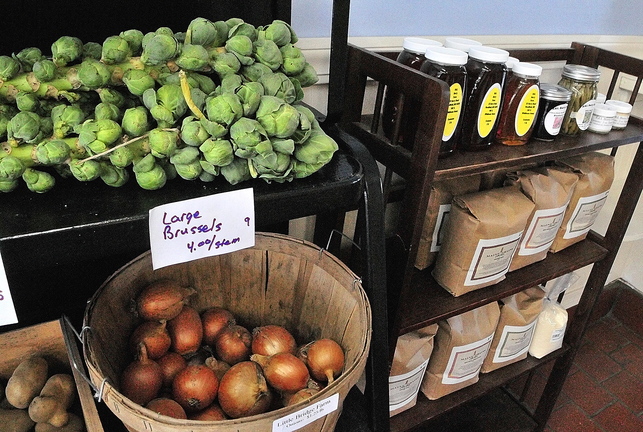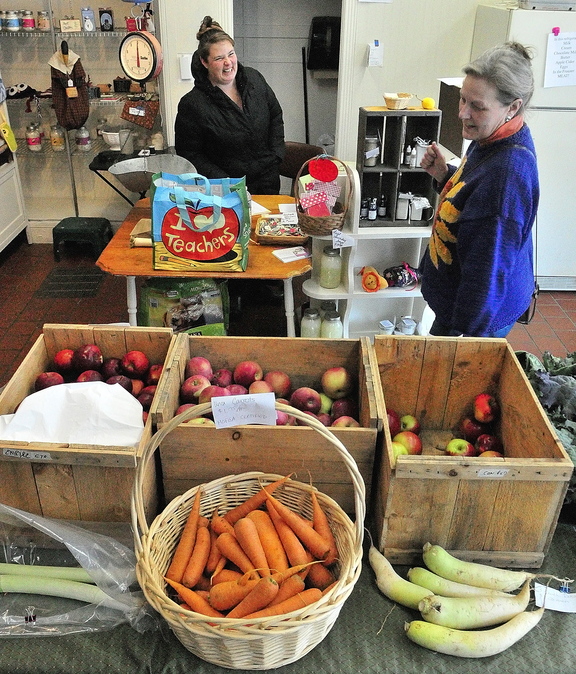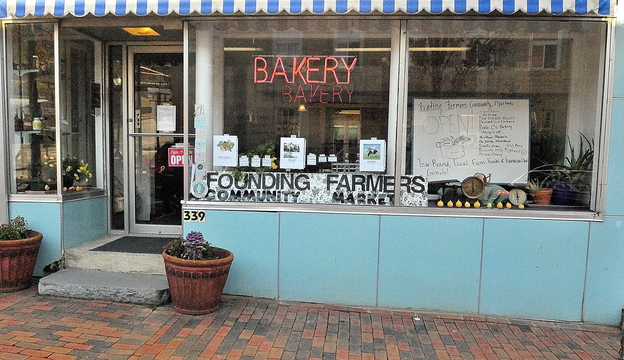GARDINER — City officials and local agriculture advocates say the local food system is a tool to not only bolster the area’s economy, but also to get more local food on tables.
“Food is a huge component of our economy,” said Nate Rudy, director of economic development for the city.
The city of Gardiner is finishing its comprehensive plan, essentially a guide for what the community wants the city to look like, and parts of the draft plan include developing a local food policy to encourage organizations and individuals to use locally sourced food products when possible and branding itself as a local food center for the region.
Rudy said the city can help by bringing stakeholders together, supporting producers and markets when possible, and ensuring the city’s zoning and land use ordinance don’t impede agricultural ventures if appropriate. He said he thinks food from the community should be considered on the same level as any other product or service produced by a business.
Mark Lapping, a professor at the Muskie School of Public Service at the University of Southern Maine and a lead researcher for a statewide project looking to strengthen Maine’s food economy, agrees that Gardiner could be in a position to be a regional leader in the local food movement.
Lapping said that Gardiner benefits from its location on the Maine Turnpike and its proximity to significant farming communities, like Bowdoinham to its south.
“I think it’s possible that Gardiner could in fact become an important place for the distribution or processing of food. Maybe a food hub in and of itself,” he said.
Lapping said it’s possible to oversaturate a region with food centers — Brunswick is making similar efforts, he said — “but we’re quite a distance from worrying about that right now.”
He estimated that only 2 to 6 percent of food consumed in Maine is produced or grown in Maine. Part of the research he’s doing for the Maine Food Strategy — a coalition of organizations and stakeholders looking for ways to grow the state’s food economy — includes finding out where people buy food and what keeps them from choosing food from local sources. Lapping said he believes it’s the first scientific study of its kind in Maine and expects results in December from the research.
Gardiner has a few options of marketing channels for local food. It hosts an active farmers market at the Waterfront Park, an online buying club is based in Gardiner, the downtown is home to a few restaurants sourcing ingredients from area farms and a couple of physical markets selling local products opened recently.
Chandler and Marcina Johnson, vendors at the Gardiner Farmers Market, opened Founding Farmers Community Market downtown at the end of last month. It sells local fruit, vegetables, meat, cheese and other products in its small storefront.
Chandler Johnson said they plan to expand with more products in the spring and will host educational classes and events in the market’s larger back room. He said the goal of the business is to provide an outlet for local farmers to sell their goods and to increase the number of people who eat food grown and raised in the area.
Johnson said one motivating factor is to try to create a more sustainable community that relies less on food grown out of state and overseas, but there’s also an economic reason to grow the local food system.
More of the money spent on products from farmers and other local producers stay in the community, said James McConnon, a specialist for the University of Maine Cooperative Extension and a professor of economics at the University of Maine. The purchases are usually redirecting the profits to local people and away from those outside the region, allowing the local farmer to hire additional workers or spend that money in the community, he said.
He didn’t know of any studies showing the specific economic effect of spending money on local food instead of food produced elsewhere, but a 2005 study from Iowa State University showed that every dollar spent at farmers markets in Iowa generated an additional 58 cents in direct sales for the economy. McConnon said a similar effect would likely be found in Maine.
Logan Johnston, who owns Oaklands Farm in Gardiner and is on the City Council, said that is the major reason why he thinks the city should educate people about he importance of spending food dollars locally. The 120-acre farm largely sells beef and hay products, often locally. Johnson said 80 percent of his beef sales are to customers within 10 miles of the farm, including a couple of downtown restaurants.
“Every dollar I earn selling someone a hamburger in Gardiner probably stays in Gardiner. That to me is the most significant factor,” Johnston said.
At the regional level, a project by a community health organization identified the greater Gardiner area as a community with a strong local food foundation.
Sarah Miller, a project coordinator for Healthy Communities of the Capital Area, said the organization’s local food access project has identified what exists for local food production for the 19 communities served by the group. Besides the greater Gardiner area, the greater Winthrop area has also been identified as having a strong local food foundation, she said.
Part of the next step of the project will be reconvening with the group in the Gardiner region to look at helping to develop a local food policy committee. The committee will include the various stakeholders involved in the food system, from municipal planners and school food service directors, to farmers and food distributors.
Miller, who is also a co-founder of the Kennebec Local Food Initiative, the online buying club in Gardiner, said the goal of a committee would be to serve as an influential voice in the community and identify ways to improve the food system.
Kennebec Local Food Initiative and Healthy Communities of the Capital Area, along with the city of Gardiner and Maine Farmland Trust, hosted a public event at Johnson Hall Performing Arts Center Tuesday evening about the future of farming in Maine and the role of agriculture in Gardiner’s economy and community.
John Piotti, executive director of Maine Farmland Trust, spoke to about a dozen attendees about the potential to grow Maine’s food system. He said it’s positive news farmers markets and community supported agriculture programs have increased in popularity in recent years, but the state has to find more marketing channels to sell products if it wants to continue growing the amount of agriculture.
“We can certainly feed the state with everything we can grow here, which is a lot more than you might think,” said Piotti, a former Democratic state lawmaker. “We could do that, but the vast majority of Maine consumers are never going to get their food by being part of a (farm sharing cooperative) or shopping at a farmers market.”
Besides increasing the opportunities for farmers and producers to sell their products, Piotti said the state and individual communities need to ensure land stays available for young farmers to operate. That’s crucial to ensuring it stays economical to run a farm, as well as eventually growing the number of acres available in the state for food production, he said.
“We’re not going to have sustainable rural communities without agriculture,” Piotti said. “Long term, it makes sense to stick with it, and I think the benefits will be huge.”
Paul Koenig — 207-621-5663pkoenig@centralmaine.comTwitter: @paul_koenig
Send questions/comments to the editors.





Success. Please wait for the page to reload. If the page does not reload within 5 seconds, please refresh the page.
Enter your email and password to access comments.
Hi, to comment on stories you must . This profile is in addition to your subscription and website login.
Already have a commenting profile? .
Invalid username/password.
Please check your email to confirm and complete your registration.
Only subscribers are eligible to post comments. Please subscribe or login first for digital access. Here’s why.
Use the form below to reset your password. When you've submitted your account email, we will send an email with a reset code.